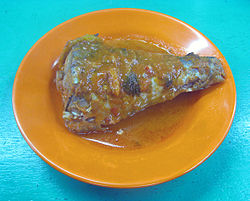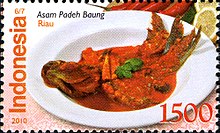 Ambu-ambu asam padeh, a Padang-style asam pedas ikan tongkol
(mackerel tuna) Ambu-ambu asam padeh, a Padang-style asam pedas ikan tongkol
(mackerel tuna) | |
| Course | Main course |
|---|---|
| Place of origin | Indonesia |
| Region or state | Sumatra |
| Associated cuisine | Indonesia, Malaysia and Singapore |
| Serving temperature | Hot or room temperature |
| Main ingredients | Fish cooked in sour and hot sauce |
Asam pedas (Jawi: اسم ڤدس; Minangkabau: asam padeh; "sour and spicy") is a Maritime Southeast Asian sour and spicy fish stew dish. Asam pedas is believed to come from Minangkabau cuisine of West Sumatra, Indonesia and has spread throughout to the islands of Sumatra, Borneo and the Malay Peninsula.
Region

The spicy and sour fish dish is endemic in the Malay Archipelago, known widely in Sumatra, Borneo and the Malay Peninsula. It is part of the culinary heritage of both Minangkabau and Malay traditions. The Minang asam padeh is commonly served at Padang restaurants in Indonesia, Malaysia and Singapore.
It has become a typical cuisine of Malays from the eastern coast of Sumatra—Jambi, Riau, Riau Islands, and as far north as Aceh and across the Strait of Malacca in Johore, Malacca, Singapore, and also coastal Borneo, especially Pontianak in West Kalimantan. The spice mixture and the fish used might be slightly different according to the area.
Preparation
| This section needs additional citations for verification. Please help improve this article by adding citations to reliable sources in this section. Unsourced material may be challenged and removed. (January 2021) (Learn how and when to remove this message) |

The main ingredients in asam pedas are usually seafood or freshwater fish. They are cooked in asam (tamarind) fruit juice with chilli and spices.
The cooking process involves soaking the pulp of the tamarind fruit until it is soft and then squeezing out the juice for cooking the fish. Asam paste may be substituted for convenience. Vegetables such as terong or brinjals (Indian eggplants), okra and tomatoes are added.
Fish and seafood—such as mackerel, mackerel tuna, tuna, skipjack tuna, red snapper, gourami, pangasius, hemibagrus or cuttlefish — either the whole body or sometimes only the fish heads are added to make a spicy and tart fish stew. It is important that the fish remain intact for serving so generally the fish is added last.
In Indonesia, the most common fish used in asam pedas is tongkol (mackerel tuna). In Lingga, the dish is preferably served with sago griddle cakes (lempeng sagu) in place of rice usual in other places.
Kaeng som is the Thai version of asam pedas. In Bengal, India there is a similar dish is called Macher tak (sour fish).
See also
References
- Boi, Lee Geok (15 September 2017). Asian Seafood. Marshall Cavendish International Asia Pte Ltd. ISBN 978-981-4794-08-4.
- "Ikan Asam Pedas Pontianak, Jenis menu masakan masyarakat Melayu". idntimes.com (in Indonesian). 2 November 2020. Retrieved 22 September 2020.
- Arman, Dedi (26 May 2019). "Pedasnya Ikan Asam Pedas Melayu". kebudayaan.kemdikbud.go.id (in Indonesian). Retrieved 22 September 2020.
- "3 Most Popular Western Malaysian Seafood Dishes".
- ^ Donny Syofyan (24 November 2013). "By the way ... I just can't live without Padang food". The Jakarta Post.
- "Serba-serbi RM Padang: Dari Rendang sampai Rahasia Saji". Kompas.com (in Indonesian). 2020-12-28. Retrieved 2021-01-07.
- Jais, Ahmad Sahir (September 2016). "Deconstructing Malay Delicacies " Asam Pedas " : Critical Ingredients and Flavor Profile" – via ResearchGate.
- "Asam pedas goes global | The Star". www.thestar.com.my. Retrieved 2020-09-22.
- ditwdb (2019-11-02). "Ikan Asam Pedas Pontianak, Jenis menu masakan masyarakat Melayu". Direktorat Warisan dan Diplomasi Budaya (in Indonesian). Retrieved 2020-09-24.
- "Asam Pedas". Tastefood. Archived from the original on 2012-01-03.
- Faris Joraimi (Apr–Jun 2021). "Mother Island: Finding Singapore's Past in Pulau Lingga". BiblioAsia. Vol. 17, no. 4. National Library Board, Singapore. pp. 30–35.
- "Kaeng-som, a Thai culinary classic".
| Common dishes |
| ||||||||||||
|---|---|---|---|---|---|---|---|---|---|---|---|---|---|
| Snacks |
| ||||||||||||
| Desserts | |||||||||||||
| Drinks |
| ||||||||||||
| Condiments | |||||||||||||
| Articles | |||||||
|---|---|---|---|---|---|---|---|
| Dishes |
| ||||||
| Snacks and desserts | |||||||
| Drinks | |||||||